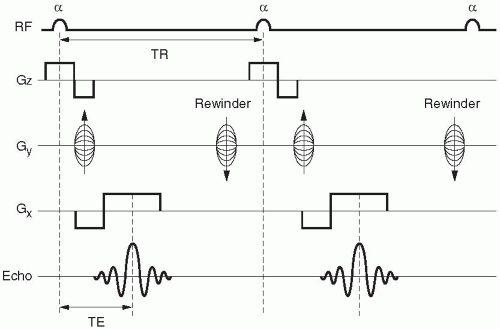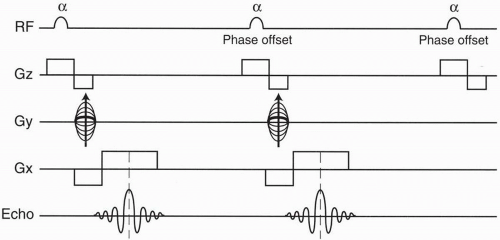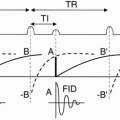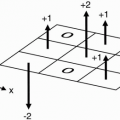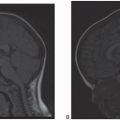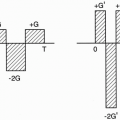Gradient Echo: Part II (Fast Scanning Techniques)
Introduction
In the last chapter, the technique of gradientecho imaging was introduced. In this chapter, several gradient-echo techniques will be discussed, including GRASS (gradient-recalled acquisition in the steady state)/FISP (fast imaging with steady-state precession), SPGR (spoiled GRASS)/FLASH (fast low-angle shot), and SSFP (steady-state free precession)/PSIF (opposite of FISP). Although every manufacturer uses a different acronym, the underlying concepts are the same. We will also discuss a multiplanar (MP) variant of these GRE techniques (e.g., MPGR-MP FISP, MPSPGR/MP FLASH). Finally, faster versions of these techniques are introduced (e.g., Fast GRASS [FGR]/Turbo FISP, Fast SPGR [FSPGR]/Turbo FLASH) as well as their MP versions (e.g., FMPGR/Fast MP FISP and FMPSPGR/Turbo MP FLASH).
Nomenclature
Table 21-1 contains a summary of the important acronyms used by three major manufacturers: General Electric (GE), Siemens, and Philips. Also refer to the list of abbreviations in the Glossary. As an example, GE uses the prefix “Fast” and Siemens uses “Turbo” to denote similar fast scanning techniques, be it gradient-recalled echo or spin echo. (The acronyms are spelled out in the Glossary.)
GRASS/FISP
It was mentioned in the last chapter that, in contrast to SE, in GRE there may be residual transverse magnetization at the end of each cycle remaining for the next cycle. This residual magnetization reaches a steady-state value after a few cycles and is denoted Mss.
This residual, steady-state magnetization is added to the transverse magnetization created by the next α radio frequency (RF) pulse and thus increases the length of the vector in the x-y plane (Fig. 21-1). This then yields more T2* weighting. In other words, tissues with a longer T2 have a longer Mss than do tissues with shorter T2.
Actually, to preserve this steady-state component, an additional step needs to be taken in the pulse sequence. A so-called rewinder gradient is applied in the phase-encoding direction at the end of the cycle to reverse the effects of the phase-encoding gradient applied at the beginning of the cycle (i.e., it “unwinds” the former effect). In other words, the rewinder gradient is nothing but the opposite of the phase-encoding gradient (Fig. 21-2). For instance, if gradient +3 is applied for phase encoding, the rewinding gradient would be −3.
SPGR/FLASH
The word “spoiling” refers to the elimination or “spoiling” of the steady-state transverse
magnetization. There are various ways of accomplishing this task:
magnetization. There are various ways of accomplishing this task:
Table 21-1 | ||||||||||||||||||
|---|---|---|---|---|---|---|---|---|---|---|---|---|---|---|---|---|---|---|
| ||||||||||||||||||
RF Spoiling. RF spoiling is the method used in SPGR and is illustrated in Figure 21-3. In this scheme, a phase offset is added to each successive RF pulse. This causes a corresponding phase shift in successive Mss vectors. By maintaining a constant phase relationship between the transmitter and the receiver (achieved via a phase-locked circuit), successive Mss vectors cancel each other out. A pulse sequence diagram (PSD) for SPGR is shown in Figure 21-4. In this scheme, rewinder gradients are naturally not used because their purpose is to preserve the steady-state magnetization, thus defeating the purpose of spoiling. An example is seen in Figure 21-5.
Variable Gradient Spoilers. Spoiling can also be achieved by using gradient spoilers. This is accomplished by introducing an additional gradient with variable strengths from cycle to cycle (Fig. 21-6).
 Figure 21-1. A-D A residual transverse magnetization that reaches a steady state Mss remains after a short TR. |
Lengthening TR. The last method to achieve spoiling of Mss is by lengthening TR. When TR is sufficiently large (generally over 200 msec), there is enough time to allow complete dephasing of the spins in the transverse plane (because TR » T2*). This is similar to the SE pulse sequence.
Question: For a long TR (e.g., 500 msec), what is the difference between GRASS (or FISP) and SPGR (or FLASH)?
Answer: There isn’t any! A TR of 500 msec in GRASS effectively allows transverse magnetization to decay away over each cycle, that is, it eliminates the steady-state component (Mss). Consequently, GRASS/FISP and SPGR/FLASH would have similar properties for any given TE and α when TR is long.
SPGR/FLASH Tissue Contrast. By eliminating the steady-state component, only the longitudinal component affects the signal in the SPGR/FLASH technique. Thus, this technique lends itself to reduced T2* weighting and increased T1 weighting. This is true provided α is also relatively large. When α is small, however, the T1 recovery curves play a minor role, and proton density (PD) weighting is increased.
 Figure 21-5. Axial spoiled gradient-echo T1 images of the abdomen. A: Without contrast-showing periportal edema (arrow) secondary to patient’s hepatitis. B: Postgadolinium with chemical (spectral) fat saturation in a different patient that shows a multiloculated lesion in the medial segment of the left lobe consistent with pyogenic abscess. |
Disadvantages of SPGR (FLASH)
Increased dephasing caused by inhomogeneities in B0
Increased magnetic susceptibility artifacts
Increased chemical shift artifacts (dark bands)
SSFP/PSIF
This technique is harder to comprehend. It yields heavily T2 (not T2*)-weighted images. The PSD is shown in Figure 21-7. The idea here is that each α RF pulse contains some 90° and some 180° pulses embedded in it. Therefore, in Figure 21-7, α1 acts like a 90° excitation pulse and α2 like a 180° rephasing pulse. This yields a pulse sequence similar to spin echo (SE) whereby an echo is formed at α3. Because it is difficult to read a signal and transmit α3 at the same time, the echo is actually recalled 9 msec prior to α3 by using an appropriate gradient. Note that the echo corresponding to α1 is formed between α2 and α3. Interestingly, in this scheme, TE is larger than TR (and smaller than 2TR by 9 msec), which is somewhat counterintuitive. The rewinder gradients are also shown in the diagram. The rewinder gradient is one cycle ahead of the phase-encoding gradient due to the mechanism described in the foregoing discussion. (In this technique, any two successive RF pulses can be employed to create an SE.)
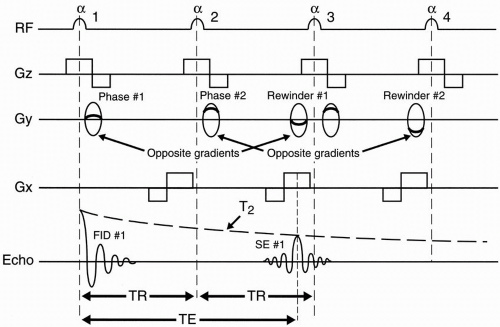 Figure 21-7. A PSD for SSFP/PSIF. Each α pulse contains some 180° pulse embedded in it that acts like a refocusing pulse. This, in turn, will result in a spin echo (SE
Get Clinical Tree app for offline access
Stay updated, free articles. Join our Telegram channel
Full access? Get Clinical Tree


|
